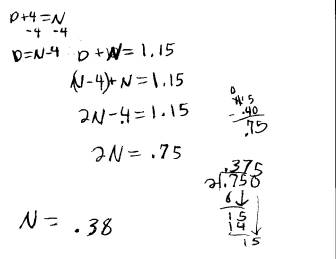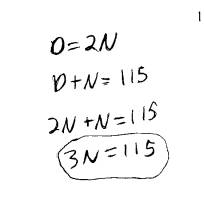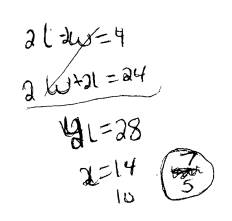Thank you for visiting our site! You landed on this page because you entered a search term similar to this: solving basic algebra equations homework word problem.We have an extensive database of resources on solving basic algebra equations homework word problem. Below is one of them. If you need further help, please take a look at our software "Algebrator", a software program that can solve any algebra problem you enter!
Though this student made a mistake on the first line, herlogic was perfect. She started out withone nickel, which meant she needed 5 dimes (4 more). By multiplying the number of nickels by 5 and adding this valueto the product of the number of dimes and 10, she was able to obtain hertotal. Using guess and check, shecontinued to increment her values for nickels until she arrived at a total of$1.15.
Four of the 6th graders obtained the correctsolution to this problem. Each was ableto explain his or her work well, and their strategies remained fairlyconsistent throughout the problem-solving sessions.
8th Grade Responses:
To my surprise, the 8th graders showed the mostdifficulty with this problem. Eachstudent started out using systems of equations to model the problem.
N = nickels, D =dimes
D = N + 4
N + D = 115
Problem #1 was consistently the most difficult and timeconsuming for the 8th graders, partly because of their stubbornefforts to force the problem to work.When I asked one stumped student what her equations meant, she replied,I dont know! I just put themdown! These students could not explaintheir work well. To provide insightinto the struggles on this problem, consider this 8th grade (whomaintains an A in the class) students work:


From the beginning, she incorrectly set up her systems bydefining the equation:
D + N = 1.15.
Her problems only became worse. Using the method of substitution, she replaced D with (N-4),only to realize that she had a decimal value on one side of the equation and awhole number on the other side. Sherealized that this was a problem, but simply added a decimal in front of the4. She had no concept of what thesevalues represented or even what her equations meant. Though she repeated her calculations several times, she could notget a satisfactory result. So she trieda different approach:

She knew that the value of a dime is equal to twonickels. Thus, she replaced her N =D+4 equation with D=2N. Itseems clear that she also has little understanding of her variablemeanings. In the same system, Dstands for a monetary value $0.10 as well as the number of dimes.
The other students displayed similar difficulties, althoughone of the four eventually remedied her mistake. Three of the five total students reverted to guess and check toobtain their final solution.
Problem #2:
1. Elinor loves to paint.She paints pictures to sell in her mothers store.
a. How much money would Elinor earn if she sold 6 largepaintings and 11 small paintings?
b. One Monday, Elinor sold only small paintings.
c. On Tuesday, Elinor sold 3 more large paintings thansmall paintings. In total, she earned$39. How many of each size painting didshe sell?
This example produced results very similar to the firstproblem. Each student was able to solveparts (a) and (b) successfully or with only insignificantarithmetic errors. Part (c) proved themost challenging.
6th Grade Responses:
Again, the 6th grade students utilized guess andcheck methods to solve this problem.Several used charts to organize their work, one would write an answerand erase it until he found the correct solution, and one student was unable tosolve the problem. The techniques werevery similar to the first problem.
8th Grade Responses:
Again, only one algebra student successfully used algebra tosolve part (c). The other students setup the system with the same error:
S = Small, L =Large
S + L = 39
L = S + 3
These students eventually solved the problem using guess andcheck methods.
Problem #3:
Arwen wants to plant a tulip garden.
a. If Arwen makes a square flowerbed with her fencing, howlong will each side be? What is thearea of this flowerbed?
b. In the square flowerbed, Arwen wants to plant 2 tulipsfor every square foot inside the flowerbed.How many tulips will she plant in the flowerbed from part(a)?
c. Arwen decided to make the flowerbed a rectangle.
This problem is geometry-based but can be solvedalgebraically. Surprisingly, only halfthe students drew a diagram while working on this problem.
Each student that drew a picture also employed the guess andcheck method. Most of these studentsused charts; one student drew the rectangles to scale using a ruler and 1 inch= 1 foot. One 6th gradestudent was quick to solve this style of problem in the previous two algebraicexamples, but had difficulty seeing any relationship between those problems andthis geometry problem. In the end, shewas successful, but could not see the same algebraic relationships that she hadused in the previous problems.
Only two of the students missed this problem.
This is an example of the correct system of equations usedby an 8th grade student:
